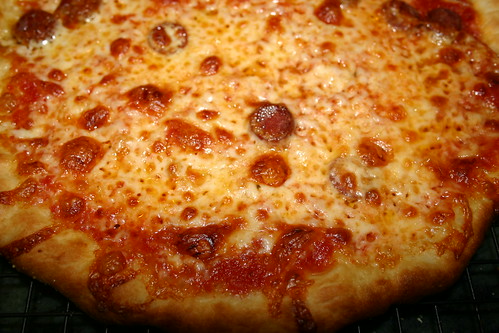
Growing up in a German family, our daily bread was rarely white. Dark-hued rye and pumpernickel were far more common. This was fine with me at least until I went to school. Seduced by the soft, squeezy texture of the white bread found in most of my friend’s lunch bags, I was done with whole grains. When I saw the bright colored, bubbly bag of the wonderful Wonder bread – Yowsa! “Air sots!” my mother would exclaim – not that I understood what those were, I assumed it was whatever gave it that beguiling texture and wan shade.
Fortunately, my palate grew up. As I started to cook for myself, most of the books I chose called for unbleached flour over bleached. When I started to bake bread, I discovered a whole new world of ingredients, such as wheatberries, spelt, teff, and farro. Gradually, my bread began to darken.
It’s pretty well-established that whole grains are good for you. Heart-healthy and high in vitamins, minerals, fiber and essential fatty acids, they regulate our systems in more way than one. What you may not know is that whole grains are also better for the planet. Whole grains and products made from whole grains are less processed than their counterparts and the more processed a food is, the greater the cost to the environment.
Both of these are very good reasons why you should eat more whole grains, but they certainly don’t address why you should want to. If you are, or if you cook for someone who’s palate hasn’t matured beyond the air sots, ethics provide little incentive. These folks need some more coaxing to come over to the dark side and I have an ingredient that will aid in that persuasion.
Whole wheat pasty flour, also known as Graham flour, is milled from soft Winter wheat. It has less gluten and more starch so it creates a softer dough or batter than whole wheat flour. It allows you to add whole grains to your pancakes and pastries without making them heavy. I keep a bag in my freezer and substitute it for or add it to the all-purpose flour called for in many of my baking recipes. It will take you a long way towards converting even the worst grain-a-phobe.
The following is one of my favorite recipes for my whole wheat pastry flour. For the wine called for in the recipe, use a drop of last night's or enjoy the remainder of the opened bottle with your meal.
Sneak-it-in-Pizza
Serves 4
I call this the Sneak-it-in Pizza because of the whole-wheat flour in the crust and because I top our family’s with fresh vegetables. Kids love pizza and would never suspect that the crust isn’t made solely from white flour. I’ve found that if you set out a bunch of vegetables and tell them to “decorate” their pizza, they will be more likely to enjoy them. It’s a chance to sneak in healthy foods, while still having fun. If you’re pressed for time, you can always use your favorite store-bought tomato sauce.
1 cup water
1 ¼-ounce package active dry yeast
½ teaspoon honey
1 tablespoon white wine, optional
¾ cup whole wheat pastry flour
1 ¾ cup unbleached all-purpose flour plus more for rolling out the dough
1 tablespoon extra-virgin olive oil
2 teaspoons kosher salt
Coarsely-ground cornmeal
1 28-ounce can of tomatoes
1 large clove of garlic, peeled
1 tablespoon extra-virgin olive oil
1 teaspoon dried oregano, crumbled
½ teaspoon good red wine or balsamic vinegar
Kosher salt and freshly ground pepper to taste
Extra-virgin olive oil
1 pound fresh mozzarella, thinly-sliced, or 12 ounces grated mozzarella
Desired toppings, preferably lots of fresh vegetables such as tomato, eggplant, red onion, summer squash, peppers, zucchini, even broccoli
Heat the water in a microwave for approximately 30 seconds until 110° F. Pour the water into a large bowl or the bowl of stand mixer. Sprinkle yeast on top and add honey, stir to combine. Let the yeast mixture sit for 5 minutes while it foams. Add white wine, the flours, olive oil and salt to the bowl. Mix with a wooden spoon or with a stand mixer fitted with a dough hook until the water is absorbed. If kneading by hand, remove the mixture from the bowl and knead on a floured surface until it is smooth and elastic, but slightly tacky. If using the mixer, knead with the dough hook for approximately 2 minutes. Remove from the bowl before the dough is completely smooth and knead by hand for a few minutes or until smooth and elastic, but slightly tacky. Put the dough into a large bowl coated with oil and cover tightly with plastic wrap. Let rise for 1 hour. If you have a pizza stone, put it in the oven at this time. Preheat the oven to 500° F. Uncover the dough, punch it down and let rise for another 45 minutes.
While the dough is rising, make the sauce. Coarsely chop the tomatoes, preferably in a blender, pulsing once or twice. Finely mince the garlic clove. Heat the oil in a medium-size sauce pan over medium heat. Add the garlic and sauté approximately 30 seconds. Add the tomatoes, oregano, salt and pepper to taste. Cook until slightly reduced, approximately 20 minutes. Add vinegar and cook for another 5 minutes.
Cut the dough into four pieces with a chef’s knife or a dough scraper. Press or roll out each piece on a lightly-floured surface. If using a pizza stone, sprinkle a sheet pan or a baker’s peel with coarsely-ground cornmeal. Lay the dough on top. Brush the edges of the dough with the olive oil. Spread a quarter of the sauce on top of the dough, top with mozzarella and then “decorate” with desired toppings. With a flip of the wrist, transfer unbaked pizza to stone in the oven. If you do not have a pizza stone, bake the pizza on a baking sheet. Close oven and reduce the temperature to 450 F. Bake for approximately 10 minutes until the edges are browned.
Do-ahead notes: The dough can be frozen. Defrost overnight in the refrigerator.
Serves 4
I call this the Sneak-it-in Pizza because of the whole-wheat flour in the crust and because I top our family’s with fresh vegetables. Kids love pizza and would never suspect that the crust isn’t made solely from white flour. I’ve found that if you set out a bunch of vegetables and tell them to “decorate” their pizza, they will be more likely to enjoy them. It’s a chance to sneak in healthy foods, while still having fun. If you’re pressed for time, you can always use your favorite store-bought tomato sauce.
1 cup water
1 ¼-ounce package active dry yeast
½ teaspoon honey
1 tablespoon white wine, optional
¾ cup whole wheat pastry flour
1 ¾ cup unbleached all-purpose flour plus more for rolling out the dough
1 tablespoon extra-virgin olive oil
2 teaspoons kosher salt
Coarsely-ground cornmeal
1 28-ounce can of tomatoes
1 large clove of garlic, peeled
1 tablespoon extra-virgin olive oil
1 teaspoon dried oregano, crumbled
½ teaspoon good red wine or balsamic vinegar
Kosher salt and freshly ground pepper to taste
Extra-virgin olive oil
1 pound fresh mozzarella, thinly-sliced, or 12 ounces grated mozzarella
Desired toppings, preferably lots of fresh vegetables such as tomato, eggplant, red onion, summer squash, peppers, zucchini, even broccoli
Heat the water in a microwave for approximately 30 seconds until 110° F. Pour the water into a large bowl or the bowl of stand mixer. Sprinkle yeast on top and add honey, stir to combine. Let the yeast mixture sit for 5 minutes while it foams. Add white wine, the flours, olive oil and salt to the bowl. Mix with a wooden spoon or with a stand mixer fitted with a dough hook until the water is absorbed. If kneading by hand, remove the mixture from the bowl and knead on a floured surface until it is smooth and elastic, but slightly tacky. If using the mixer, knead with the dough hook for approximately 2 minutes. Remove from the bowl before the dough is completely smooth and knead by hand for a few minutes or until smooth and elastic, but slightly tacky. Put the dough into a large bowl coated with oil and cover tightly with plastic wrap. Let rise for 1 hour. If you have a pizza stone, put it in the oven at this time. Preheat the oven to 500° F. Uncover the dough, punch it down and let rise for another 45 minutes.
While the dough is rising, make the sauce. Coarsely chop the tomatoes, preferably in a blender, pulsing once or twice. Finely mince the garlic clove. Heat the oil in a medium-size sauce pan over medium heat. Add the garlic and sauté approximately 30 seconds. Add the tomatoes, oregano, salt and pepper to taste. Cook until slightly reduced, approximately 20 minutes. Add vinegar and cook for another 5 minutes.
Cut the dough into four pieces with a chef’s knife or a dough scraper. Press or roll out each piece on a lightly-floured surface. If using a pizza stone, sprinkle a sheet pan or a baker’s peel with coarsely-ground cornmeal. Lay the dough on top. Brush the edges of the dough with the olive oil. Spread a quarter of the sauce on top of the dough, top with mozzarella and then “decorate” with desired toppings. With a flip of the wrist, transfer unbaked pizza to stone in the oven. If you do not have a pizza stone, bake the pizza on a baking sheet. Close oven and reduce the temperature to 450 F. Bake for approximately 10 minutes until the edges are browned.
Do-ahead notes: The dough can be frozen. Defrost overnight in the refrigerator.







No comments:
Post a Comment